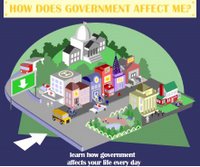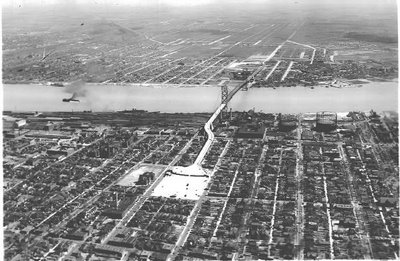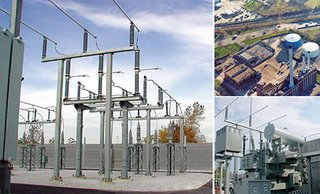
It's a different perspective worthy of some consideration at the least before we dish out billions of taxpayer dollars to build a border crossing that disrupts two communities in Michigan and Ontario and which may not be needed for years. If only Eddie would fix the roads on our side now rather than posture for re-election.
I had posted previously (BLOG March 17, 2006, "Eddie's New Border Worry") the Detroit News article by two consultants to the Bridge Co., Gary Wolfram, George Munson Professor of Political Economy at Hillsdale College and Craig Ruff, senior policy fellow at Public Sector Consultants and lecturer at the Gerald R. Ford School of Public Policy.
They testified in the Michigan hearings at Lansing and what they said was very interesting. The Star was at the session and picked up the comments about them being "hired guns."
Of course they are, just like say, a world renowned traffic guru. They made the point, as Gridlock Sam did, that you can buy their time but NOT their opinion.
It is unfortunate as well that the Star did not report what Senator Leland also said. He said he had known one of the speakers (or perhaps both I cannot remember now) for a considerable period of time and respected his opinions.
Their Report is now public since it was submitted at the hearings. I read the entire document and thought you might want to think about some of the things they discussed. Here is the Executive Summary:
Another Michigan-Ontario Border Crossing?
A Solution in Search of a Problem
Executive Summary
INTRODUCTION
With much fanfare, the Detroit River International Crossing (DRIC) study on November 14, 2005, unveiled its conclusion that a new bridge be constructed in 2013 across the Detroit River, creating another link between Detroit and Windsor. The $32-million study rejects the cost-effective option of a privately funded twinning of the Ambassador Bridge. A new bridge, plaza, and roadway connections likely will cost about $3 billion, about $2 billion of which constitutes Canada’s share of a new bridge and its essential investment in a plaza and roadway connections in Windsor. Public policy–makers in Michigan now must examine the objectivity of the study and scrutinize a conclusion that, if implemented, will cost Michigan and the United States about one billion taxpayer dollars.
CONCLUSIONS
We find no near-term need for a new crossing. When and if demand warrants new lanes connecting Detroit and Windsor, the Detroit International Bridge Company (owner of the Ambassador Bridge) is prepared to invest in building a new span, thus freeing taxpayer dollars to meet other public needs.
More specifically:
The DRIC’s continually erroneous projections of border crossing demands raise serious issues about the validity of its 30-year projections.
If demand by commuters, tourists, and truckers should outstrip the current capacity of the bridges and tunnel, it is preferable to depend upon the investment of the private sector rather than the public sector.
The number of lanes crossing the border will not affect congestion and delays for many years to come. Congestion problems are a function of the number of inspection booths, the number of customs personnel, and the preparedness of motorists.
On the U.S. side, the Gateway Project, upon completion in 2008, will alleviate congestion and provide smooth access to the Ambassador Bridge. The $225-million project ($185 million of state and federal dollars and $40 million invested by the Detroit International Bridge Company) is designed in large part to anticipate a second span of the Ambassador Bridge.
The two major impediments to efficient commercial vehicle flow between southwest Ontario and southeast Michigan are the poorly planned plaza at the Blue Water Bridge (government owned) and the roadway between the end of Highway 401 in Windsor and the foot of the Ambassador Bridge. Canada has avoided improving access to the Ambassador Bridge for decades. Canada now seeks to build a new highway across largely vacant and industrial land in Canada and a new plaza. The new bridge will also require a plaza and roadway connections in Michigan that will be duplicative of the Gateway Project improvements.
The $1 billion that Michigan and the United States would have to invest in their share of a new bridge comes at the steep expense of worthier and essential transportation improvements in our state.
Any bridge expansion, as it becomes necessary, should be privately owned, since this will result in more efficient use of resources and more consistent maintenance.
U.S. federal policymakers expressly acknowledge and place importance on private marketplace forces. Signed into law on August 10, 2005, the six-year transportation funding legislation, known as the Safe, Accountable, Flexible, Efficient Transportation Equity Act: A Legacy for Users, encourages public support for private sector transportation infrastructure projects.
QUESTIONABLE RATIONALE FOR A NEW BRIDGE
DRIC press releases trumpet various rationales for a new bridge, including:
Over the next 30 years, trade between Canada and the U.S. is projected to increase significantly.
Under high-growth scenarios, cross-border traffic demand could exceed the capacity of the present border crossings in the Detroit River area as early as 2015.
Unless steps are taken to address capacity at the Detroit-Windsor crossings, mounting congestion and delays will result in lost production, and ultimately fewer jobs in communities throughout both countries.
DRIC press releases do not mention that:
Every traffic demand projection by government transportation planners throughout the DRIC’s study has proven wrong and required overhaul. The planners have guessed wrong even on a one-year projection, let alone a 30-year horizon.
The taxpayers of Michigan and Ontario—not transportation planners—will foot a bill of about $3 billion for a new bridge, new inspection plaza or plazas, and new connections to regional freeways. Michigan taxpayers will bear a burden for Ontario’s failure to provide for enhanced and safer connections from Highway 401 in Windsor to the Ambassador Bridge.
Congestion and long delays are today virtually nonexistent. Infrequent delays are not due to a shortage of lanes crossing the river, but rather to inspection issues, facilities, and staffing. Readers may find current waiting times at http://www.cbsa-asfc.gc.ca/general/times/menu-e.html. We have checked that site numerous times in late November and early December and have not seen any reported delays at Port Huron or Detroit.
In the last three years of the DRIC’s work, models projecting demand (even short-term) have had to be overhauled twice. Commissioned forecasts of future demands by travelers and haulers of freight across the Michigan/Ontario border started with a base year of 2000. Seeing major changes in actual crossings, researchers changed the base year to 2002. Again seeing major changes thereafter, researchers had to change the base year to 2004. Notwithstanding such wide fluctuations in projections over a four-year period, the DRIC uses a 30-year projection of demand to defend its conclusion that a new bridge must be built.
The planning for the Blue Water Bridge shows a similar inability of government to forecast traffic demands. The three-lane Blue Water Bridge was experiencing unacceptable backups in 1992, when its total annual traffic was 6.0 million vehicles. Planners judged that insufficient lanes caused backups and determined that a second span would alleviate delays. In 1998 the second three-lane span opened, and traffic stood at 5.2 million vehicles annually—a volume nearly 15 percent lower than in 1992.
The Blue Water Bridge still—in 2005—does not carry enough traffic to justify the second span. The congestion of 1992 had nothing to do with the number of lanes. The problem was always a shortage of customs booths and poor plaza design. The only constraint on capacity—both today and in years past—is inadequate inspection capabilities. That is true for other crossings as well.
Given the poor track record of Canadian-U.S. government studies, and the fact that the Ambassador Bridge is currently operating at much less than full capacity, that overall traffic has been flat for the past six years, and that closures of and cutbacks at Michigan and Ontario auto plants are threatening to dampen cross-border shipping, we seriously doubt that there is an impending need for additional bridge capacity. Indeed, all evidence points to inspection booth capacity as the crucial need in the intermediate and long term.
Between Toronto and Chicago or Toledo, there are two major impediments to the efficient flow of commercial vehicles. One is the U.S. plaza at the Blue Water Bridge. The second is the stretch of six miles (through commercial districts and 17 traffic lights) between Highway 401 in Windsor and the foot of the Ambassador Bridge. Confronting these obstacles—not building new lanes across the border—should be the focus of government planners. The Ambassador Bridge and the Michigan Department of Transportation have led in ensuring that inspection capacity is met through the Gateway Project, a constructive private/public partnership that will improve access to the bridge and relieve traffic congestion on the Detroit side.
To head off future congestion, the Detroit International Bridge Company is spending $50 million (over and above investment in the Gateway Project) to expand the U.S. plaza. That will serve the needs of border inspectors for at least 50 years. The firm has accurately diagnosed the potential source of congestion.
A NEW BRIDGE: PUBLIC OR PRIVATE?
If a new bridge becomes necessary as a result of future demand, it should be privately owned. The privately owned and operated Ambassador Bridge has a 76-year history of being safe and well maintained. The private sector has a greater incentive than government to maintain a safe bridge. Consumers have several alternatives for traveling between Ontario and Michigan. If a private company does not keep its bridge in good working order, travelers will take alternative routes and tolls—the sole source of revenue—will decline.
Unlike government, a private firm must make sure that the cost of building a bridge will be met by income generated by its use. Government agents who decide on the size of the bridge do not risk their own assets—but rather taxpayers’ investment—in making this decision. The fees for a government-owned bridge will be set through the political process.
United States policymakers expressly acknowledge and place importance on private marketplace forces. They do so through the recently enacted six-year transportation funding legislation known as the Safe, Accountable, Flexible, Efficient Transportation Equity Act: A Legacy for Users. That law encourages public support for private sector transportation infrastructure projects. Signed into law on August 10, 2005, the act allows the issuing of tax-exempt private activity bonds to finance highway projects and rail-truck transfer facilities. This allows state and local governments to finance private companies’ construction of such projects and facilities, including international tunnels and bridges. States, too, are moving to capitalize on private operation of integral transportation facilities. Examples include the privatization in January 2005 of Illinois’ Chicago Skyway toll road under a 99-year operating lease and Indiana’s exploration of privatizing I-69.
Government legitimately plans to meet future transportation needs and has an essential function to ensure safe roads and highways. Increasingly, government is finding that there is great value in private operation of transportation corridors...
FURTHER CONCLUSIONS
Despite the offer by the Ambassador Bridge’s owners to build a twin bridge and plazas on both the American and Canadian sides of the border, Canada aggressively resists twinning the Ambassador Bridge because its officials do not want to build the required access roads. Their concern about the impact on surrounding neighborhoods must fall on deaf ears in the neighborhoods of southwest Detroit, an area that is host to three interstate highways.
...Once environmental and planning approvals are in place, a new bridge can be built in about three years—that was the length of time required to build the second span of the Blue Water Bridge.
Through the $225-million Gateway Project, the Michigan Department of Transportation, the United States Federal Highway Administration, and the DIBC are preparing roads, ramps, and an expanded plaza between the Ambassador Bridge and interstate highway system to handle expected traffic for at least the next 35 years. The Gateway Project was planned to serve the twinning of the Ambassador Bridge.
The Ambassador Bridge’s owners are spending another $50 million or more to build a plaza that will serve the needs of border inspectors for at least 50 years.
...With proper staffing of the expanded plaza proposed by the Ambassador Bridge’s owners, congestion will be minimized for the foreseeable future.
The impetus for new construction and expenditures comes, in part, from Ontario and Canada, which have no plans to confront and pay for road development to deliver traffic from Highway 401 to the Ambassador Bridge. The DRIC’s American representatives have acceded to the wishes of Canada and have agreed to consider spending about $1 billion for the United States portion (half of the cost of a new bridge and all of Michigan’s plaza and roadway connections).
A new bridge will not lessen the threat of interruption of commerce and travel brought on by terrorist actions. Prevention of terrorist action requires aggressive inspection of vehicles prior to driving onto a bridge or into a tunnel.

















